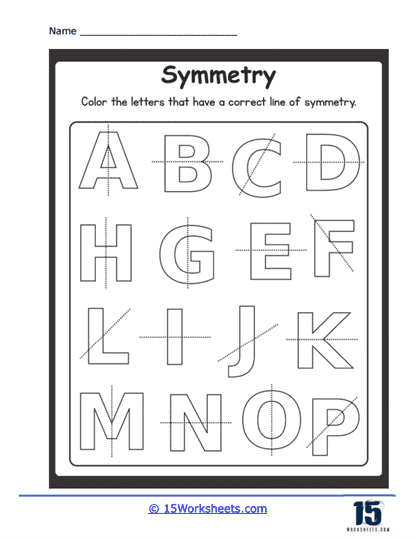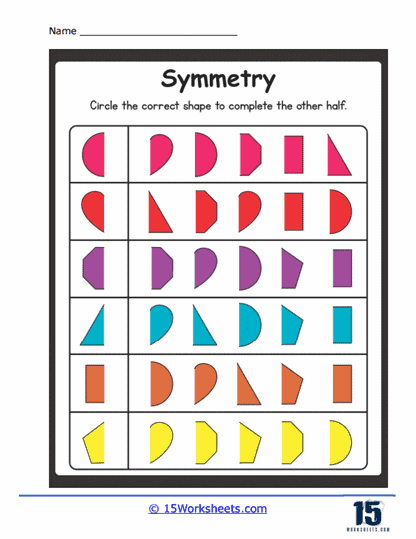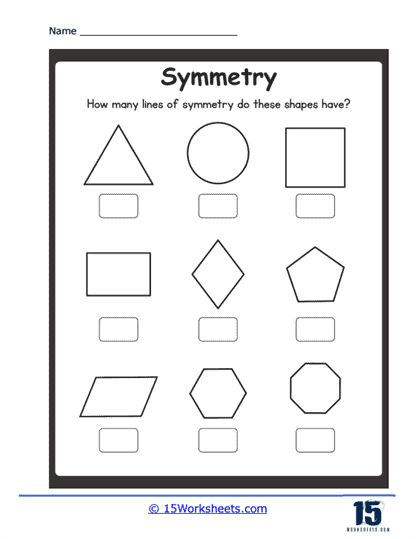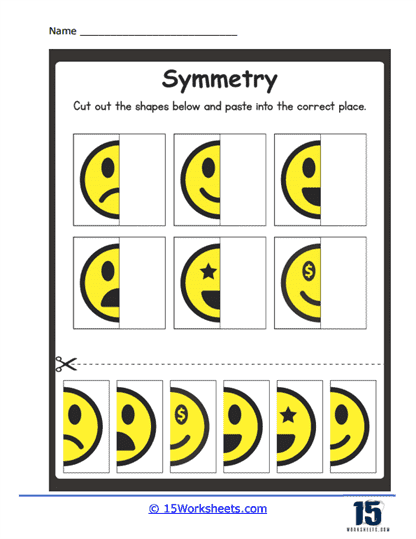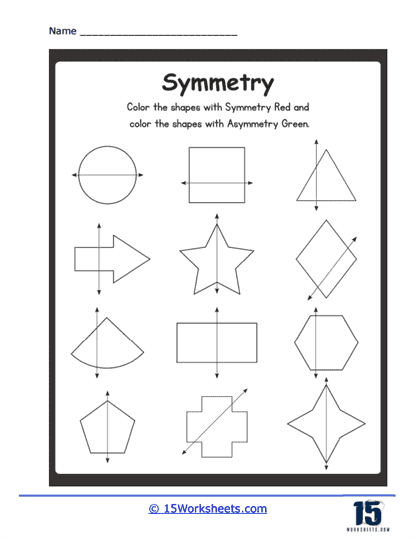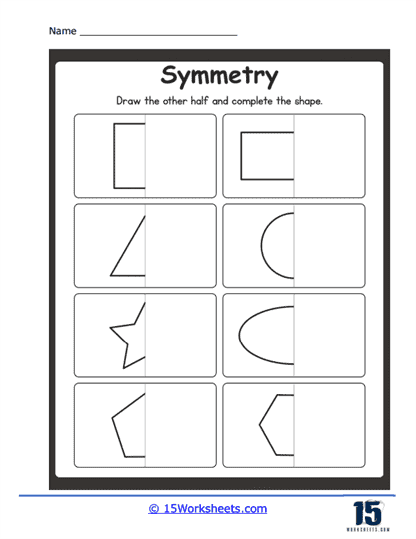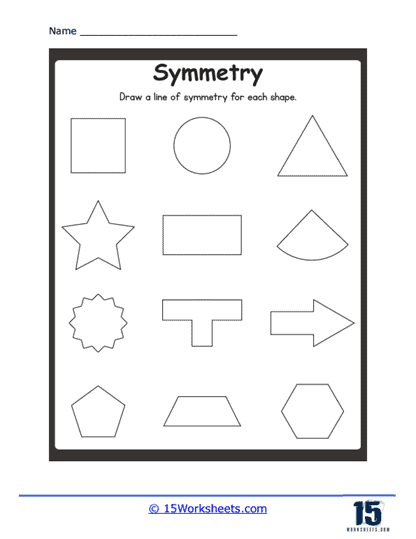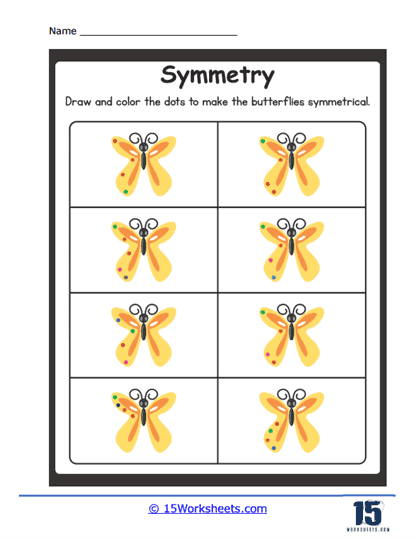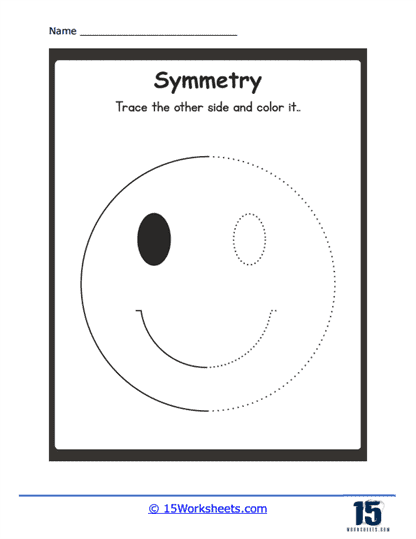Symmetry Worksheets
About These 15 Worksheets
These worksheets help students understand and explore the concept of symmetry in mathematics. Symmetry is a fundamental aspect of geometry that deals with the balanced and proportional arrangement of shapes and figures. These worksheets provide a variety of activities and exercises that help students recognize, analyze, and create symmetrical shapes and patterns. By engaging with these worksheets, students develop a deeper understanding of symmetry, which is crucial for their overall mathematical development.
Symmetry worksheets include a range of exercises that focus on different aspects of symmetry, such as identifying lines of symmetry, completing symmetrical figures, drawing symmetrical shapes, and analyzing the symmetry of letters and everyday objects. These activities not only enhance students’ understanding of geometric properties but also improve their spatial reasoning and visual perception skills. Symmetry worksheets are often used in elementary and middle school classrooms to reinforce geometry lessons and provide hands-on practice with symmetrical concepts.
Math Skills Explored
Our symmetry worksheets explore several essential math skills that are vital for students’ success in geometry and other areas of mathematics. One of the primary skills is spatial reasoning. Spatial reasoning involves the ability to visualize and manipulate objects in three-dimensional space, which is crucial for understanding how symmetrical shapes and figures are constructed and balanced. By working on symmetry worksheets, students develop their spatial awareness and improve their ability to think critically about geometric properties.
Another important skill emphasized in symmetry worksheets is pattern recognition. Recognizing and analyzing patterns is a key aspect of mathematical thinking, and symmetry worksheets provide numerous opportunities for students to identify and create symmetrical patterns. These exercises help students develop their ability to recognize balanced and proportional arrangements, which is essential for their overall mathematical reasoning.
Measurement and calculation are also important skills explored in symmetry worksheets. Students practice using geometric concepts to measure and analyze symmetrical shapes and figures. They learn to calculate the properties of symmetrical objects, such as their area, perimeter, and volume, reinforcing their understanding of how geometric properties relate to symmetry.
Types of Exercises
Symmetry worksheets typically include a wide variety of exercises and practice problems, each designed to reinforce the concepts and skills mentioned above. Here are some common types of exercises you might find:
Identifying Lines of Symmetry – These exercises ask students to identify and draw lines of symmetry in various shapes and figures. Students might be given a diagram of a shape and asked to draw the line (or lines) that divide the shape into two symmetrical halves. This helps students understand the concept of reflective symmetry and how it applies to different geometric figures.
Completing Symmetrical Figures – In these problems, students are given half of a symmetrical figure and must draw the other half to complete the shape. This exercise helps students develop their ability to recognize and create symmetrical patterns, reinforcing their spatial reasoning skills.
Drawing Symmetrical Shapes – Students are asked to draw shapes that are symmetrical about a given line or axis. This task requires students to think critically about the properties of symmetry and how to create balanced, proportional figures.
Analyzing Symmetry in Letters – These exercises involve identifying lines of symmetry in letters of the alphabet. Students might be given a list of letters and asked to color or mark the ones that have a correct line of symmetry. This activity helps students see how symmetry applies to everyday objects and symbols.
Symmetry in Everyday Objects – Students analyze and identify lines of symmetry in common objects, such as fruits, sports equipment, and household items. This task makes learning about symmetry relevant and engaging by connecting it to real-world examples.
Symmetry Matching Games – These worksheets include matching exercises where students pair symmetrical halves to create complete figures. This activity helps students practice recognizing and analyzing symmetrical properties in a fun and interactive way.
Coloring Symmetrical Patterns – Students color shapes and patterns to create symmetrical designs. This exercise combines creativity with geometric reasoning, helping students understand how symmetry can be used to create balanced and aesthetically pleasing patterns.
Cut-and-Paste Symmetry Activities – These worksheets involve cutting out shapes and pasting them in the correct place to complete symmetrical figures. This hands-on activity reinforces students’ understanding of symmetry through practical application.
Benefits of Symmetry Worksheets
One of the primary advantages is that these worksheets provide a structured approach to learning about symmetry. By breaking down the concept into manageable activities and exercises, students can more easily understand and apply symmetrical properties.
Another significant benefit is that symmetry worksheets promote active learning. By engaging with the material through various exercises and problems, students actively participate in the learning process. This active engagement helps students retain information better and develop a deeper understanding of geometric concepts.
Symmetry worksheets also help students develop critical thinking and problem-solving skills. By working through different types of problems, students learn to approach mathematical challenges systematically and logically. This skill is invaluable not only in mathematics but also in other areas of study and in everyday life.
These worksheets help students make connections between theoretical mathematics and real-world applications. By presenting problems in practical contexts, these worksheets show students how geometric principles can be applied in various fields and industries.
Real World Uses of Symmetry
Architecture and Construction
In architecture and construction, symmetry plays a crucial role in designing buildings and structures. Symmetrical designs are often more aesthetically pleasing and provide a sense of balance and harmony. Architects use symmetry to create visually appealing facades and layouts, ensuring that buildings are not only functional but also attractive. Symmetry can also contribute to structural stability, as symmetrical buildings often distribute weight more evenly, reducing the risk of collapse. Understanding symmetry helps architects and engineers design structures that are both beautiful and safe, enhancing the built environment.
Art and Design
Artists and designers frequently use symmetry to create balanced and visually appealing works. In art, symmetry can be found in various forms, from perfectly mirrored images to more subtle symmetrical patterns. Designers use symmetry in logos, graphics, and layouts to create a sense of order and harmony. Understanding symmetry allows artists to experiment with different compositions and achieve desired aesthetic effects, while designers can create effective and engaging visual communications that capture attention and convey messages clearly.
Fashion and Textiles
In fashion and textiles, symmetry is often used to create patterns and designs that are pleasing to the eye. Symmetrical patterns in fabrics, clothing, and accessories contribute to a sense of order and elegance. Fashion designers use symmetry to create garments that fit well and look balanced on the body. Understanding symmetry helps designers craft clothing and textiles that are both stylish and functional, appealing to consumers’ sense of beauty and symmetry.
Medicine and Biology
Symmetry is a fundamental concept in medicine and biology, particularly in the study of human anatomy and the natural world. Many organisms, including humans, exhibit bilateral symmetry, where the left and right sides of the body are mirror images. Understanding this symmetry is essential for medical professionals when performing surgeries, diagnosing conditions, and understanding bodily functions. In biology, studying symmetrical patterns in plants and animals can provide insights into evolutionary processes and the underlying principles of growth and development.
Robotics and Automation
In robotics and automation, symmetry is important for designing robots and automated systems that move and function efficiently. Symmetrical designs in robots ensure that movements are balanced and stable, reducing the risk of malfunction. Understanding symmetry allows engineers to create robots that can perform tasks with precision and reliability. For instance, symmetrical grippers can handle objects more effectively, and symmetrical walking robots can navigate various terrains more easily.
Mathematics and Physics
Symmetry is a key concept in mathematics and physics, where it helps in solving problems and understanding fundamental principles. In mathematics, symmetry is used to simplify equations and solve complex geometric problems. In physics, symmetrical properties of objects and systems can reveal conservation laws and fundamental forces. Understanding symmetry allows mathematicians and physicists to develop theories and models that explain the natural world, leading to advancements in technology and science.
Environmental Science and Ecology
In environmental science and ecology, symmetry is often observed in the natural world and can indicate the health and stability of ecosystems. Symmetrical patterns in plants, animals, and landscapes can reflect underlying environmental conditions and processes. Understanding these patterns helps ecologists monitor biodiversity, assess environmental impacts, and develop conservation strategies. Symmetry in natural systems can also inspire sustainable design and engineering practices that mimic nature’s efficiency.
Health and Fitness
In health and fitness, understanding symmetry can help in designing balanced exercise programs and assessing physical health. Symmetry in body movements and postures is often associated with better physical performance and reduced risk of injury. Fitness professionals use symmetry to create workout routines that develop strength and flexibility evenly across the body. Understanding symmetry helps individuals achieve better physical health and maintain proper form during exercise, leading to improved overall well-being.
Everyday Problem-Solving
In everyday life, understanding symmetry can enhance problem-solving and decision-making skills. Symmetrical arrangements often lead to more efficient use of space and resources, whether it’s organizing a room, arranging a garden, or planning a layout. Recognizing symmetrical patterns can also help in identifying solutions to practical problems and improving aesthetic appeal in various tasks. Understanding symmetry provides a useful tool for tackling everyday challenges with creativity and efficiency.







